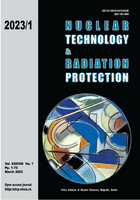
STUDY ON OCCUPATIONAL EXPOSURE OF MEDICAL STAFF CAUSED BY INDUCED RADIOACTIVITY IN THE TREATMENT ROOM OF MEDICAL HEAVY-ION FACILITY
Pages: 39-47
Authors: Changli Luo, Wuyuan Li, Bo Yang, Youwu Su, Yang Li, Shakhboz Khasanova, Wang Mao, Xuebo Liu, Weiwei Yan, and Zongqiang LiAbstract
Heavy-ion radiotherapy is currently recognized as the most advanced particle therapy method and is being vigorously promoted and applied worldwide. This method can rapidly generate radiation and induce radioactivity during treatment. However, the induced radioactivity, which is the primary source of exposure for medical staff, does not disappear following therapeutic application in the treatment room. In this study, we investigated the characteristics, dose rate distribution, and impact of this induced radioactivity on medical staff in the treatment room (uniform scanning mode) at Gansu Wuwei Tumor Hospital using experimental measurement and Monte Carlo simulation. We found that the exposure dose experienced by medical staff is predominantly related to the irradiated patients for single irradiation and the irradiated beam delivery system for long-term irradiation. The half-lives of the main radionuclides ranged from a few minutes to tens of minutes for single irradiation and from tens of days to hundreds of days for long-term irradiation. The primary radionuclide contributors are 15O, 11C, 176Ta, and 177W.
We also estimated the personal dose experienced by the medical staff in the treatment room in relation to their working patterns. The results showed that the maximum annual exposure dose of medical staff in the horizontal treatment direction under the current model was 0.728 mSv. We hypothesized that an appropriate increase in the patient's treatment could reduce the annual exposure dose of medical staff to 0.650 mSv without changing the total treatment time per day. Finally, some suggestions were made to reduce the exposure of medical staff to unwanted radiation.
Key words: heavy ion, Monte Carlo, induced radioactivity, dose assessment
FULL PAPER IN PDF FORMAT (999 KB)
